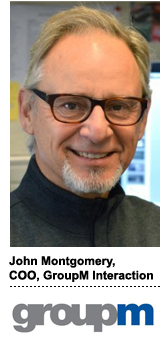 John Montgomery, COO of GroupM Interaction, North America will appear at AdExchanger’s upcoming CleanAds I/O conference on June 3, an event addressing inventory quality and supply chain issues in the digital advertising ecosystem.
John Montgomery, COO of GroupM Interaction, North America will appear at AdExchanger’s upcoming CleanAds I/O conference on June 3, an event addressing inventory quality and supply chain issues in the digital advertising ecosystem.
GroupM’s stance on viewability is clear: “If an ad can’t be seen, then we can’t expect clients to pay for it,” said John Montgomery, COO of GroupM, North America. “Frankly, if an ad isn’t viewable, it’s worthless, and if the viewer is a machine, then it’s criminal. Either way, our clients aren’t going to pay for it.”
GroupM and its client Unilever announced last year that they would only count 100% in-view display impressions, in stark contrast to the MRC’s blessing of 50% in view for one second. And while the MRC’s standard calls for 50% of videos to be in view for at least two continuous seconds, GroupM has said that its advertisers will not accept anything less than 100% in-view players and 50% of the video content viewed, with the audio on and autoplay off.
Condé Nast has agreed to trade on these higher guarantees, although the publisher recently went public with the caveat that the same rules don’t apply to native.
Publishers have “really taken this challenge to heart,” Montgomery said. Many large publishers, including Yahoo, have redesigned their sites to be more viewable. And although the MRC only lifted its advisory a little over a year ago, in that time, Montgomery said, GroupM has seen a 20% to 30% improvement in campaign viewability.
“Call it viewability by design, if you like, but it’s amazing how far we’ve come,” he said. “It’s been a tough and traumatic time for a lot of publishers who needed to change the way they display ads, but it was necessary for us to rebuild trust in the digital marketplace. We acknowledge the great work the MRC did in creating the first benchmark, but we know that it’s possible to get sufficient reach at the higher GroupM standard.”
Which is not to say that there wasn’t significant pushback from both the publisher community and the IAB when GroupM first made its 100%-or-bust announcement last year.
As viewability levels improve, the amount of viewable inventory that’s available takes a natural dip – and most publishers want to be compensated accordingly. As Stephen Howard-Sarin, eBay’s head of display advertising, said in no uncertain terms at AdExchanger’s San Francisco Programmatic I/O in April: “It’s a different product, [and] it’s a different price.”
But Montgomery is undaunted by that point of view, referring to ANA CEO and president Bob Liodice’s recent statement that its members would only pay for “measurably viewable” ads as an affirmation of GroupM’s own position and evidence of where the industry is going.
“We’re working with our publisher partners to help them make their properties as viewable as they possibly can,” Montgomery said. “It may not happen instantly, but they’ve fully accepted the fact that we’re not going to pay for non-viewable impressions. The faster our partners move, the faster they’ll get paid for more inventory. It’s in the entire industry’s best interests.”
Given the current limitations of measurement technology, the IAB has said that 2015 will be a “year of transition,” during which time 100% viewability for campaigns simply isn’t possible yet – but Montgomery doesn’t see why that has to be the case.
“Sherrill Mane [SVP of research, analytics and measurement at the IAB] has said that we can’t get from A to B immediately, that we have to get there slowly,” Montgomery said. “Okay. But imagine standing in front of a client and saying, ‘We want you to pay for a portion of ads that were not viewable.’ Why would a client agree to that? We understand – and our clients understand – that it will take some time for publishers to get up to 100% viewability in terms of delivery. We completely accept that. However, you can’t expect clients to pay for it in the meantime.”
Fraud: A Fight On A Different Front
But that’s viewability. Fraud is another issue, and it needs to be treated as such.
 The Interactive Advertising Bureau, 4As and the Association of National Advertisers are all extremely keen on keeping the dialogue around fraud and viewability as unclouded by rhetoric as possible.
The Interactive Advertising Bureau, 4As and the Association of National Advertisers are all extremely keen on keeping the dialogue around fraud and viewability as unclouded by rhetoric as possible.
The three bodies, representing the interests of publishers, agencies and advertisers, respectively, joined forces in November to form the Trustworthy Accountability Group, a cross-industry coalition now helmed by Mike Zaneis, EVP of public policy at the IAB, aimed at combating ad fraud, ad-supported piracy and malware.
“There’s a massive amount of resources and effort behind TAG because these are simply some of the biggest issues in digital to solve,” Montgomery said. “We all need to work together in the industry to do that, and no one understands that better than the publishers themselves. We can’t afford for clients to be second-guessing the digital channel.”
“Viewability sits inside a system that also includes a lot of other priorities in the digital supply chain,” said Bill Tucker, EVP of 4As’ media practice. “And it’s becoming increasingly clear that while measurement and viewability are part of a broader plan to move to a digital GRP and cross-platform measurement, the supply chain component has to be an absolute priority.”
And it is, said Scott Cunningham, SVP of ad ops and tech at the IAB and general manager of the IAB Tech Lab.
“We’ve gone head over heels to separate the dialogue around these things,” he said. “Yes, they’re both problems for the industry, but one is a legal issue and the other, simply, is not. The notion that there is a cause and effect relationship between the two is misinformed. They’re both complicated issues, and they need to be separated.”
In other words, everyone can agree that fraud is something that needs to be stamped out, full stop. But making headway on the viewability issue is far more nuanced. Bloated ads with too many data calls that take too long to load, below-the-fold placements, nonrendered served ads and bad creative, for example, can all have a serious impact on viewability, but fraud doesn’t necessarily have anything to do with it.
The MRC’s viewable impression standard clearly states that “all fraudulent impressions are invalid (but not all invalid impressions are fraudulent), and impressions known to be fraudulent can never be viewable impressions.”
George Ivie, CEO and executive director of the MRC, told AdExchanger that the council has plans to introduce another set of standards in the near term that bolster the requirements for filtering, detecting and deleting invalid traffic.
“Solving for viewability doesn’t mean that those viewable impressions are going to be made by a human or that they’re all legitimate, and likewise, if you filter fraud, it doesn’t mean that all the remaining impressions are viewable,” Ivie said. “Both issues need solving, and it’s on the agenda.”













